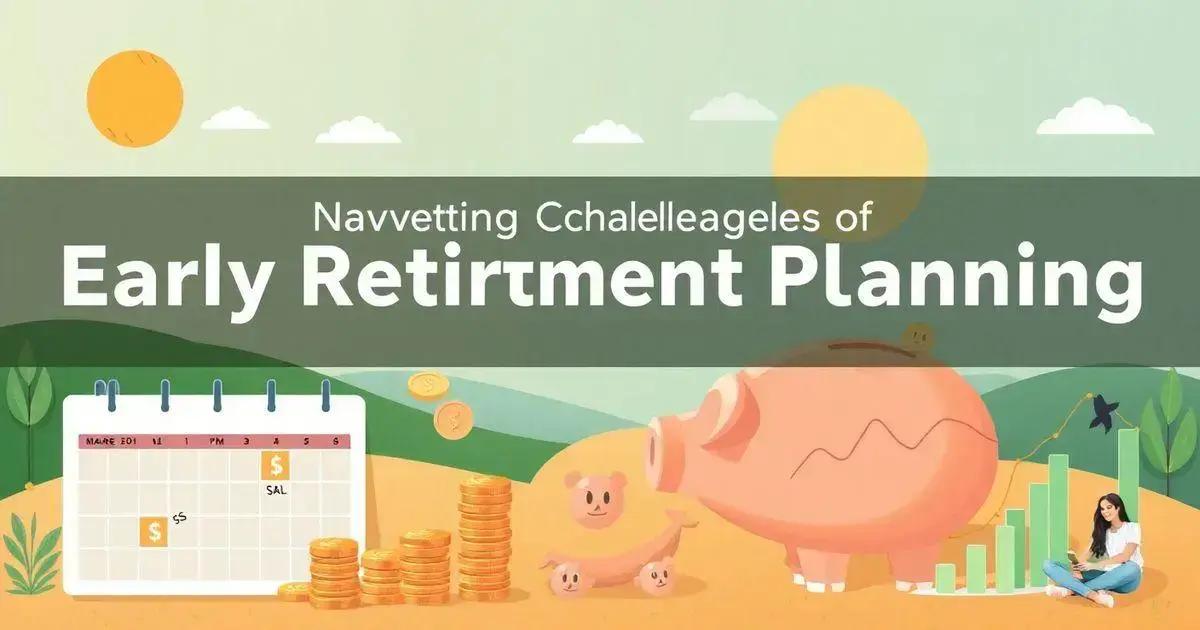Early Retirement Planning: How to Secure Credit to Achieve Financial Freedom Sooner
Imagine waking up every day with the freedom to do what you truly love—without worrying about work or finances. Maybe you dream of traveling the world, spending more time with family, pursuing hobbies, or even starting a passion project. Early retirement makes this possible, but achieving it requires careful planning, smart financial decisions, and a long-term vision.
For many people, retirement seems like something far in the future—something to think about “later”. However, the earlier you start planning for retirement, the sooner you can achieve financial independence. The truth is, early retirement isn’t just for the ultra-wealthy or lucky individuals who stumble upon a fortune. It’s a goal that anyone can achieve with the right mindset, strategy, and financial discipline.
If you want to retire early, you must be proactive. The traditional retirement age is around 65 years old, but what if you could leave the workforce in your 50s, 40s, or even your 30s? While this might seem impossible, many people have successfully done it by following proven financial strategies that focus on saving aggressively, investing wisely, and reducing unnecessary expenses.
In this guide, we will explore:
✔ Why early retirement is possible and how it can transform your life
✔ The key financial habits that lead to financial independence
✔ How to create a retirement plan that works for you
✔ Smart investment strategies to grow your wealth faster
✔ Common mistakes to avoid when planning for early retirement
By the end of this article, you’ll have a clear roadmap to help you take control of your financial future and start working towards early retirement today.
Why Your Credit Score Matters
Many people don’t realize just how important their credit score is until they need it. Your credit score is more than just a number—it’s a financial passport that lenders, landlords, and even some employers use to evaluate your reliability.
How Your Credit Score Affects Your Life
✔ Loan and Credit Card Approvals – Banks and credit card companies check your score before approving applications. A higher score means better approval chances and lower interest rates.
✔ Lower Interest Rates – A strong credit score helps you qualify for lower interest rates on loans and credit cards, saving you money over time.
✔ Renting an Apartment – Many landlords check credit scores before renting apartments. A poor score can lead to higher security deposits or even rejection.
✔ Job Opportunities – Some employers, especially in financial industries, review credit reports before hiring. A healthy credit score can improve your chances of landing a job.
✔ Better Insurance Rates – Many insurance companies use credit scores to determine car and home insurance premiums. A higher score may mean lower insurance costs.
With so many aspects of life affected by credit, improving your credit score should be a financial priority.
Quick Tips to Improve Your Credit Score
Now that we understand why credit scores matter, let’s focus on simple and effective ways to boost your score quickly.
1. Pay Your Bills on Time
One of the biggest factors affecting your credit score is your payment history. Lenders want to see that you consistently pay your bills on time.
✔ How to do it:
- Set up automatic payments to ensure bills are paid before the due date.
- Use a calendar or reminders to track payment deadlines.
- If you’ve missed a payment, pay it as soon as possible—late payments hurt less the older they get.
Even one missed payment can lower your credit score, so timely payments should be a top priority.
2. Reduce Your Credit Card Balances
Your credit utilization ratio (how much credit you’re using compared to your total credit limit) plays a major role in your score. Ideally, you should keep your credit utilization below 30%.
✔ How to do it:
- Pay down existing credit card balances as quickly as possible.
- Ask for a credit limit increase (but don’t spend more!).
- Avoid maxing out your credit cards, even if you pay them off monthly.
Lowering your credit card balances can significantly boost your score within a few weeks.
3. Check Your Credit Report for Errors
Errors in your credit report can unfairly lower your score. It’s essential to check your credit report regularly and dispute any inaccuracies.
✔ How to do it:
- Get a free copy of your credit report from credit bureaus like Experian, Equifax, or TransUnion.
- Look for incorrect late payments, accounts that don’t belong to you, or wrong balances.
- Dispute errors directly with the credit bureau—fixing mistakes can quickly improve your score.
Many people find that fixing errors adds points to their score almost immediately.
4. Keep Old Credit Accounts Open
Closing old credit accounts can hurt your credit score by reducing your overall credit history length and utilization ratio.
✔ How to do it:
- Keep old credit cards open, even if you don’t use them frequently.
- If you must close a card, close the newest ones first.
- Use old cards for small purchases and pay them off to keep them active.
A longer credit history helps lenders trust you as a responsible borrower.
5. Limit New Credit Applications
Every time you apply for a new credit card or loan, a hard inquiry is recorded on your credit report. Too many inquiries in a short period can lower your score.
✔ How to do it:
- Only apply for credit when necessary.
- If shopping for loans, do so within a short time frame (30 days) to minimize impact.
- Avoid signing up for too many store credit cards—they often come with high interest rates and little benefit.
Being selective with new credit applications helps protect your score.
6. Diversify Your Credit Mix
Having a mix of credit types—such as credit cards, auto loans, student loans, or mortgages—shows lenders that you can handle different forms of credit responsibly.
✔ How to do it:
- If you only have credit cards, consider adding a small personal loan or a credit-builder loan.
- Avoid taking on new debt just to improve your credit mix—make sure it fits your financial goals.
A diverse credit profile can help improve your score over time.
7. Become an Authorized User on Someone’s Credit Card
If a friend or family member has a long-standing credit card with a strong history, becoming an authorized user can help boost your score.
✔ How to do it:
- Ask a trusted person to add you as an authorized user on their credit card.
- Ensure the account has a good payment history and low balance.
- You don’t even have to use the card—just being on the account can improve your credit.
This strategy is especially helpful for young adults or those rebuilding credit.
Understanding the Benefits of Early Retirement Planning
Early retirement planning offers numerous benefits, including reduced stress, increased savings, and a sense of financial security. With a well-planned retirement, individuals can enjoy their golden years without worrying about money. In fact, a study by the Employee Benefit Research Institute found that 60% of workers aged 45-54 are concerned about not having enough money for retirement. By starting early, individuals can take advantage of compound interest, automate their savings, and make adjustments to their budget and investment strategy. With a clear plan, early retirement is achievable, allowing individuals to pursue their passions and live life on their own terms.
Setting realistic financial goals is crucial for early retirement planning. This involves assessing one’s income, expenses, and savings rate to determine the necessary amount needed for retirement. A common mistake is to underestimate expenses, leading to a shortfall in retirement savings. To avoid this, individuals should create a detailed budget, account for inflation, and consider all sources of income, including Social Security and pensions. By setting realistic goals, individuals can create a sustainable plan, adjust their spending habits, and make informed investment decisions.
Compound interest plays a significant role in early retirement planning, allowing individuals to grow their savings over time. When combined with consistent saving and investing, compound interest can provide a substantial nest egg. For example, if an individual saves $5,000 per year for 20 years, earning an average annual return of 7%, they can accumulate over $200,000. By starting early and taking advantage of compound interest, individuals can build a substantial retirement fund, providing financial security and peace of mind.
Navigating the challenges of early retirement planning requires careful planning, discipline, and flexibility. Common obstacles include market volatility, inflation, and unexpected expenses. To overcome these challenges, individuals should diversify their investments, maintain an emergency fund, and regularly review their plan. Additionally, they should prioritize their goals, adjust their spending habits, and consider alternative sources of income. By being prepared and adaptable, individuals can overcome the obstacles and achieve their early retirement goals.
Creating a sustainable income stream for early retirement involves a combination of passive income, investments, and smart financial planning. This includes diversifying income sources, such as rental properties, dividend-paying stocks, and bonds. Additionally, individuals should prioritize tax-advantaged accounts, such as 401(k) and IRA, and consider annuities for guaranteed income. By creating a sustainable income stream, individuals can maintain their lifestyle in retirement, enjoy financial freedom, and pursue their passions without worrying about money.
Setting Realistic Financial Goals for Early Retirement

Setting Realistic Financial Goals is a crucial step in early retirement planning. It involves assessing your income, expenses, and savings rate to determine the necessary amount needed for retirement. A common mistake is to underestimate expenses, leading to a shortfall in retirement savings. To avoid this, create a detailed budget, account for inflation, and consider all sources of income, including Social Security and pensions. By setting realistic goals, you can create a sustainable plan, adjust your spending habits, and make informed investment decisions. Remember to prioritize your goals, automate your savings, and regularly review your progress to stay on track.
The role of Compound Interest in early retirement planning cannot be overstated. When combined with consistent saving and investing, compound interest can provide a substantial nest egg. For example, if you save $5,000 per year for 20 years, earning an average annual return of 7%, you can accumulate over $200,000. By starting early and taking advantage of compound interest, you can build a substantial retirement fund, providing financial security and peace of mind.
Navigating the Challenges of early retirement planning requires careful planning, discipline, and flexibility. Common obstacles include market volatility, inflation, and unexpected expenses. To overcome these challenges, diversify your investments, maintain an emergency fund, and regularly review your plan. Additionally, prioritize your goals, adjust your spending habits, and consider alternative sources of income. By being prepared and adaptable, you can overcome the obstacles and achieve your early retirement goals.
Creating a Sustainable Income Stream for early retirement involves a combination of passive income, investments, and smart financial planning. This includes diversifying income sources, such as rental properties, dividend-paying stocks, and bonds. Additionally, prioritize tax-advantaged accounts, such as 401(k) and IRA, and consider annuities for guaranteed income. By creating a sustainable income stream, you can maintain your lifestyle in retirement, enjoy financial freedom, and pursue your passions without worrying about money.
The Role of Compound Interest in Early Retirement Planning
Compound Interest plays a crucial role in early retirement planning, as it allows your savings to grow exponentially over time. By starting early and taking advantage of compound interest, you can accumulate a substantial nest egg, providing financial security and peace of mind. For example, if you save $5,000 per year for 20 years, earning an average annual return of 7%, you can accumulate over $200,000. Additionally, consider the power of compound interest in tax-advantaged accounts, such as 401(k) and IRA, to maximize your retirement savings.
Creating a Sustainable Income Stream for early retirement requires a combination of passive income, investments, and smart financial planning. This includes diversifying income sources, such as rental properties, dividend-paying stocks, and bonds. Additionally, prioritize tax-advantaged accounts, such as 401(k) and IRA, and consider annuities for guaranteed income. By creating a sustainable income stream, you can maintain your lifestyle in retirement, enjoy financial freedom, and pursue your passions without worrying about money.
Navigating the Challenges of early retirement planning requires careful planning, discipline, and flexibility. Common obstacles include market volatility, inflation, and unexpected expenses. To overcome these challenges, diversify your investments, maintain an emergency fund, and regularly review your plan. Additionally, prioritize your goals, adjust your spending habits, and consider alternative sources of income. By being prepared and adaptable, you can overcome the obstacles and achieve your early retirement goals.
Setting Realistic Financial Goals for early retirement involves assessing your income, expenses, and savings rate to determine the necessary amount needed for retirement. A common mistake is to underestimate expenses, leading to a shortfall in retirement savings. To avoid this, create a detailed budget, account for inflation, and consider all sources of income, including Social Security and pensions. By setting realistic goals, you can create a sustainable plan, adjust your spending habits, and make informed investment decisions.
Navigating the Challenges of Early Retirement Planning

Navigating the Challenges
Navigating the challenges of early retirement planning requires careful planning, discipline, and flexibility. While the dream of retiring early is enticing, it comes with a unique set of financial and lifestyle considerations that demand thoughtful strategies and continuous adjustments.
Understanding the Key Challenges of Early Retirement
One of the most significant challenges of early retirement is ensuring that your savings last for the rest of your life. Common obstacles include market volatility, inflation, and unexpected expenses. Without a steady paycheck, these factors can become even more daunting.
1. Market Volatility
The stock market is unpredictable, and economic downturns can quickly erode your retirement savings. A heavy reliance on stock-based investments without a diversified portfolio can put your financial security at risk.
2. Inflation Risk
The cost of living continues to rise, and inflation can significantly impact your purchasing power over the years. If your savings and investments don’t outpace inflation, you may find yourself needing to cut back on expenses or return to work.
3. Unexpected Expenses
Medical emergencies, home repairs, and other unforeseen costs can derail even the most well-thought-out retirement plan. Without an adequate safety net, these surprises can lead to financial stress and disrupt your long-term goals.
Strategies to Overcome Early Retirement Challenges
To overcome these challenges and build a sustainable early retirement plan, consider the following strategies:
1. Diversify Your Investments
A well-balanced investment portfolio that includes stocks, bonds, real estate, and other assets can help reduce risk. By diversifying, you minimize the impact of market fluctuations and create multiple streams of income.
2. Maintain an Emergency Fund
Having an emergency fund with at least six to twelve months’ worth of living expenses can serve as a financial cushion. This ensures that unexpected expenses won’t force you to withdraw from your retirement savings prematurely.
3. Regularly Review and Adjust Your Plan
Your financial situation and market conditions will change over time. Reviewing your retirement plan at least once a year allows you to make necessary adjustments and stay on track with your goals.
4. Prioritize Your Goals
Clearly defining your retirement goals—whether it’s traveling, relocating, or starting a new venture—will help you allocate your resources effectively. Having a clear vision makes it easier to stick to a plan and make informed financial decisions.
5. Adjust Your Spending Habits
Being mindful of your spending habits is essential for long-term financial stability. Track your expenses, differentiate between needs and wants, and eliminate unnecessary costs to ensure your savings last.
6. Consider Alternative Income Sources
Exploring alternative income streams, such as rental properties, dividends, freelancing, or part-time work, can provide additional financial security. This approach reduces the need to rely solely on your savings and allows you to maintain financial independence longer.
7. Plan for Healthcare Costs
Healthcare can be one of the most significant expenses in retirement. Research health insurance options, consider long-term care insurance, and factor in potential medical costs to ensure you’re financially prepared for any health-related needs.
Achieving Your Early Retirement Goals
By being prepared and adaptable, you can overcome obstacles and achieve your early retirement goals. A well-thought-out plan that includes diversified investments, controlled spending, and alternative income sources will give you the flexibility needed to navigate financial challenges.
Early retirement is not just about quitting work—it’s about achieving financial freedom and living life on your own terms. By staying disciplined, continuously educating yourself about personal finance, and making informed decisions, you can enjoy a secure and fulfilling retirement.
Creating a Sustainable Income Stream for Early Retirement
FAQ – Frequently Asked Questions about Early Retirement Planning
What are the benefits of early retirement planning?
Early retirement planning allows you to prepare financially for a comfortable retirement, reducing the risk of outliving your assets and ensuring a sustainable income stream.
How can I set realistic financial goals for early retirement?
To set realistic financial goals, assess your income, expenses, and savings rate, and consider factors such as inflation and market volatility.
What role does compound interest play in early retirement planning?
Compound interest can significantly grow your retirement savings over time, making it a critical component of early retirement planning.
How can I navigate the challenges of early retirement planning?
To navigate the challenges, prioritize financial planning, diversify your investments, and maintain an emergency fund.
What is a sustainable income stream for early retirement?
A sustainable income stream includes a combination of passive income, investments, and smart financial planning, ensuring a consistent income in retirement.
Can I create a sustainable income stream for early retirement?
Yes, with careful planning and consideration of factors such as tax-advantaged accounts and annuities, you can create a sustainable income stream for early retirement.

